Introduction
Florida has a diversity of habitats that support a rich flora and fauna. Juan Ponce de Leon, who explored Florida in 1513 in search of the mythical "Fountain of Youth," recognized Florida for its beauty. Ponce de Leon claimed Florida for Spain and named this new land "Pascua de Florida," which translates as "feast of flowers." Florida was sold to the United States in 1819 and became the 27th state of the United States on March 3, 1845.
Today, Florida is known as the Sunshine State. The state capitol resides in Tallahassee. In honor of Florida's natural resources, state legislators have identified numerous state symbols.
Florida State Animal
Florida panther (Puma concolor coryi)
Size: males—about 7 feet, 85–155 pounds; females—about 6 feet, 50–100 pounds
Range: south Florida
Habitat: pinelands, hardwood hammocks, mixed swamp forests
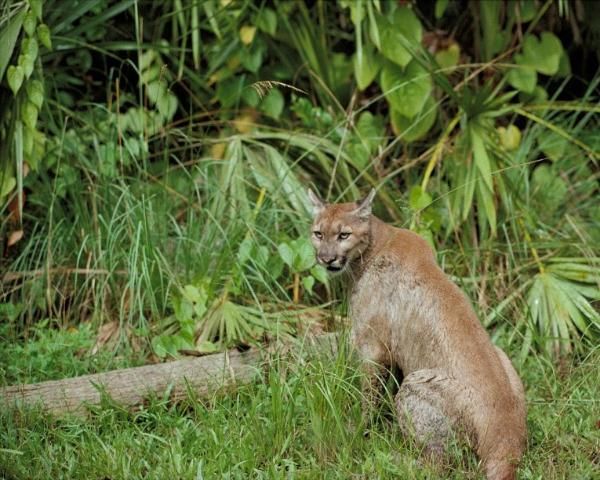
Credit: USFWS
Fun Facts:
- home range size averages 75 square miles for females, 200 sq. mi. for males
- females give birth to 1–5 kittens that stay with the mother for 1–2 years
- listed as state and federally endangered
- they can run a few hundred yards at their max speed, 35 mph
- they can travel 15–20 miles in a day
- lifespan 12–15 years in the wild
In 1982, students throughout Florida chose the Florida panther over the manatee, alligator, and Florida Key deer to be designated as the Florida state animal. With numbers estimated at only 120 to 230 animals, the panther is not only one of Florida's most endangered species, but one of the most endangered mammals in the world. A relative of the western cougar, the Florida panther needs vast tracks of wild lands to procure food and mates without conflicting with neighboring panthers. Captive breeding programs helped establish a stable population of panthers and increased genetic diversity of the population. Unfortunately, Florida's rapidly expanding population is continually pushing development farther into panther territory. Despite increased awareness and concern, continued loss of habitat paints a bleak future for the Florida panther.
Florida State Marine Mammal
West Indian manatee (Trichechus manatus latirostris)
Size: up to 13 feet long and 3,000 pounds
Range: southeastern United States and Bahamas but can travel to Rhode Island and Texas with warm waters
Habitat: rivers, canals, estuaries, saltwater bays
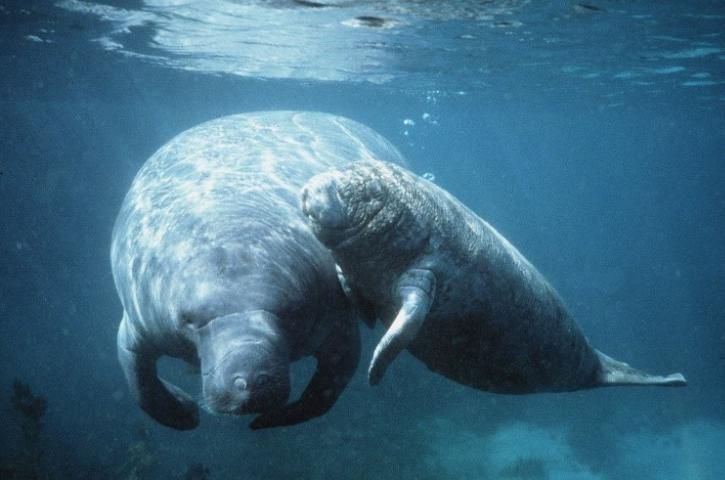
Credit: UF/IFAS
Fun Facts:
- eats 60–100 pounds of aquatic vegetation each day
- sleeps on the bottom; surfaces every 5–20 minutes to breathe
- related to elephants, hyraxes, and aardvarks
- ribs and long bones lack marrow cavities; these solid bones serve the same purpose as a diver's weights
- snout is prehensile, meaning it can grab food and other objects, just like your hand
- brain is smooth rather than fissured
- lifespan up to 60 years
In 1975, the legislature designated the West Indian manatee the state marine mammal. Although the name has at times caused confusion, the West Indian manatee is native to Florida, as well as the West Indies (Caribbean Islands) and portions of Central and South America. The manatee is a large, slow-moving mammal that lives in Florida's coastal estuaries and rivers, where it eats massive quantities of aquatic plants. These gentle giants must surface for air approximately every five minutes, which puts them in danger of collision with motorboats. Approximately 25 percent of all recorded manatee deaths are caused by motorboats, and many more animals are injured each year. Slow speed zones have been implemented in many Florida waterways in an effort to protect manatees. Listed as endangered by the United States Fish and Wildlife Service under the Endangered Species Act since 1973, in 2006, manatees were down-listed to threatened as their populations started to recover. The manatee population in Florida is estimated between 2,500 to 3,500 animals. Management strategies that have helped them recover will remain in place to ensure their survival long-term.
Florida State Saltwater Mammal
Bottlenose dolphin (Tursiops truncatus)
Size: adult 6 to 13 feet, 330 to 1400 pounds
Range: worldwide
Habitat: brackish waters, river mouths, oceans, bays, estuaries
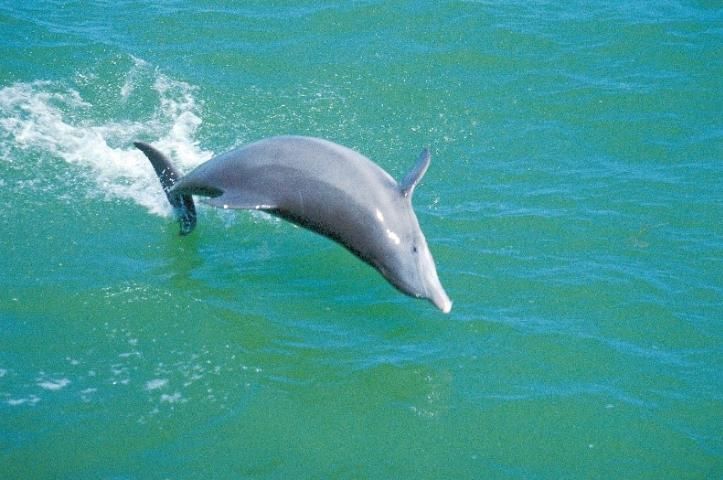
Credit: Lee Island Visitor and Convention Bureau
Fun Facts:
- live in family groups (2–15 individuals) known as "pods"; multiple pods form herds
- reproduce one offspring every 2–3 years
- interact with humans in the wild
- use echolocation to find prey
- lifespan 40–50 years
The 1975 Florida Legislature designated the "porpoise," which is a term that is sometimes used to describe the bottlenose dolphin, as the official Florida saltwater mammal. Although porpoises and dolphins are related (Order Cetacea), there are no true porpoises found in Florida waters. Bottlenose dolphins are frequently observed in Florida's coastal waters and are known for their playfulness, often racing abreast or in the wake of motorboats. Typical dolphin antics include breaching and mid-air twists. Historically, sailors have considered the presence of dolphins as a sign of good luck. Pollutants, habitat destruction, biotoxins, direct harvest, viral outbreaks, and accidental injury and mortality from commercial fishing gear threaten dolphins. The stability of their population is unknown.
Florida State Saltwater Fish
Sailfish (Istiophorus platypterus)
Size: Atlantic variety—up to 11 feet, 25–50 pounds
Range: worldwide; Atlantic and Gulf of Mexico coasts
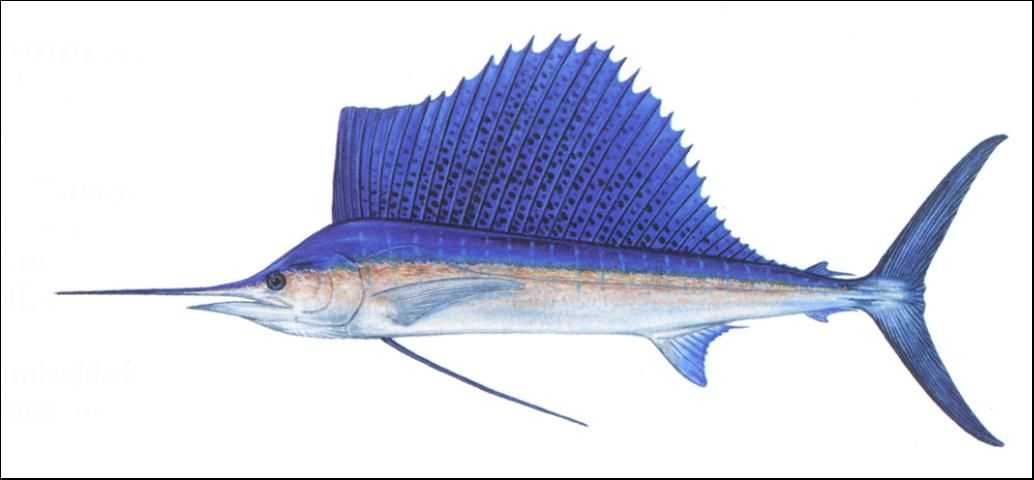
Credit: Diane Peebles
Fun Facts:
- typically live about 5 years
- groups of sailfish raise sails to corral schooling fish
- can swim 68 mph, faster than marlin
- color varies based on excitement level
The Atlantic sailfish was first described in 1792. Today, sailfish are a popular saltwater game fish in Florida's offshore waters. They are named for their large, sail-like dorsal fin that is raised when they are excited or come to the surface. Sailfish become "excited" when fighting anglers, catching prey, and competing for mates. Sailfish are brilliantly colored with dark, iridescent blue on top, silver on the belly, and purple stripes on the back. They often travel and feed in schools. Sailfish are known among anglers for their fighting ability and tendency to leap out of the water. In recent years, sailfish populations have declined across their range from overfishing and accidental harvest by commercial fishers. Anglers are encouraged to catch and release this beautiful state fish.
Florida State Freshwater Fish
Florida largemouth bass (Micropterus salmoides floridanus)
Size: maximum length 3 feet, averages 4–8 pounds
Range: Florida, introduced in other states
Habitat: prefers warm, slow-moving water
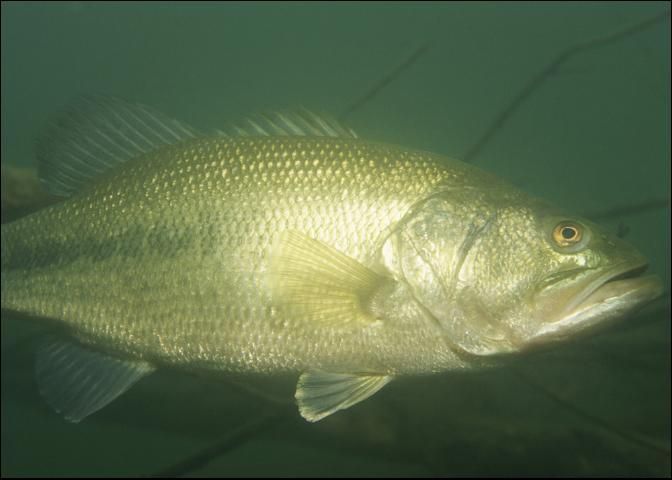
Credit: USFWS
Fun Facts:
- Florida's official largemouth bass record is 17.27 pounds
- the world-record bass weighed 22 pounds, 4 ounces and was caught in Montgomery Lake, Georgia, on June 2, 1932
- one of the most widely distributed fish in the world
Florida designated the largemouth bass as the state freshwater fish in 1975. Florida is the only state to have two official state fish symbols (e.g., saltwater and freshwater). The largemouth bass may well be the most popular freshwater game fish in the United States. Largemouth bass are native to or stocked in freshwater ponds, lakes, and rivers in nearly every state. The Florida largemouth bass is a subspecies of the northern largemouth bass and is known to grow faster than northern races. Although Florida largemouth bass were originally found only in Florida, they have been stocked elsewhere in the United States (e.g., Texas and California), and across the world (e.g., South Africa, Japan, Europe, and New Zealand).
Florida State Reptile
American alligator (Alligator mississippiensis)
Size: adult female—averages 8 feet, 160 pounds; adult male—averages 11 feet, 400 pounds
Range: North Carolina to Florida; west to central Texas
Habitat: swamps, deep marshes, lakes, ponds, rivers, canals
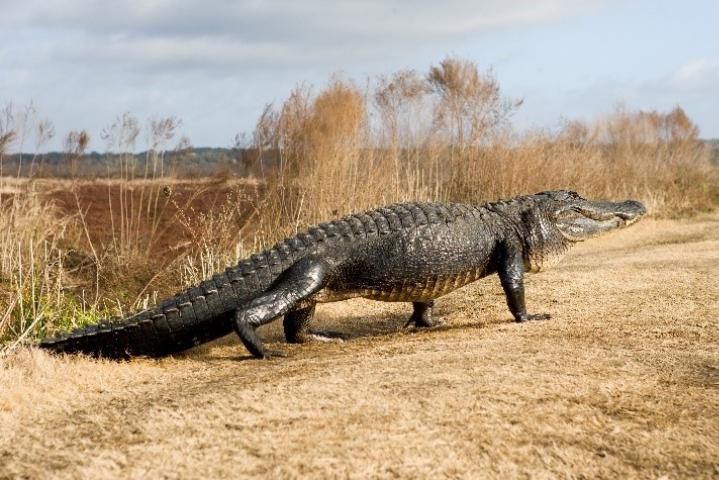
Credit: Tyler Jones, UF/IFAS
Fun Facts:
- largest record alligator from Florida measured 19 feet long
- alligators lose and replace 2,000–3,000 teeth in a lifetime
- alligators wallow out deep holes in wetlands that create important habitat for other animals
In 1987, the American alligator was designated the official Florida state reptile. Alligators occur in freshwater ponds, lakes, and rivers throughout Florida and are characterized by their broad, rounded snouts and dark color. In contrast, Florida crocodiles occur in marine and estuarine waters of extreme south Florida and have light coloration, narrow snouts, and protruding teeth. Alligators were hunted nearly to extinction and were listed as an endangered species in 1967. With proper management and protection, alligator populations recovered and are plentiful in Florida today. Increased numbers of alligators and a growing human population in the state increases risks of alligator-human conflicts. This is particularly true for alligators that are fed because they lose their fear of humans and begin to see humans as a source of food. It is not only dangerous but illegal to feed alligators in Florida.
Florida State Shell
Horse conch (Triplofusus giganteus)
Size: 4–24 inches long
Range: North Carolina to Florida and Texas
Habitat: sandy, shallow marine waters near shore
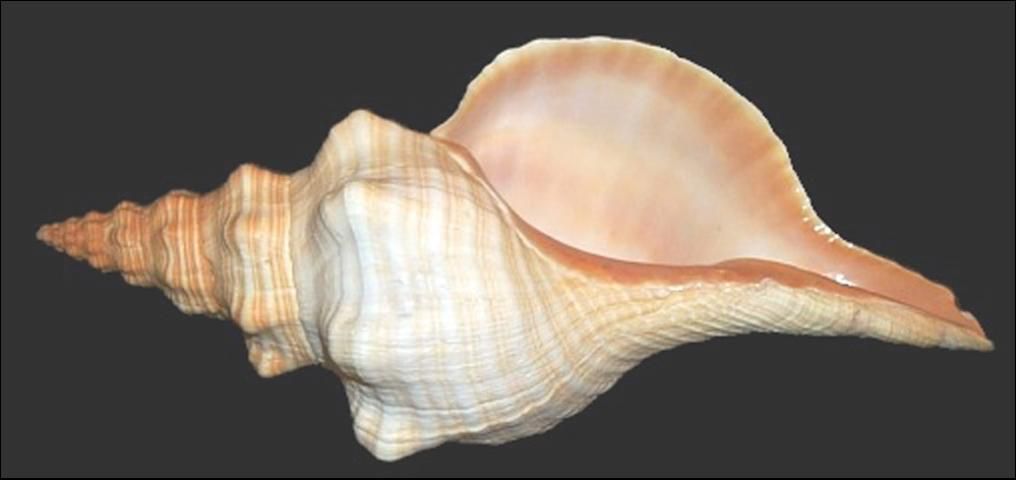
Credit: Jacksonville Shell Club
Fun Facts:
- largest marine snail in Florida waters
- predatory; grabs other snails and inserts toothed tongue to devour soft flesh
The horse conch, also known as the giant band shell, was designated Florida's state shell in 1967. The horse conch is native to marine waters surrounding Florida. It is the largest snail (shell) found in Florida's coastal waters and one of the largest in the world. It is often found in sea grass meadows, where it hunts other snails.
Florida State Bird
Northern mockingbird (Mimus polyglottos)
Size: 9–11 inches
Range: from southern Canada to southern Mexico, West Indies and introduced in Hawaii
Habitat: urban areas, farms, roadsides, dense thickets
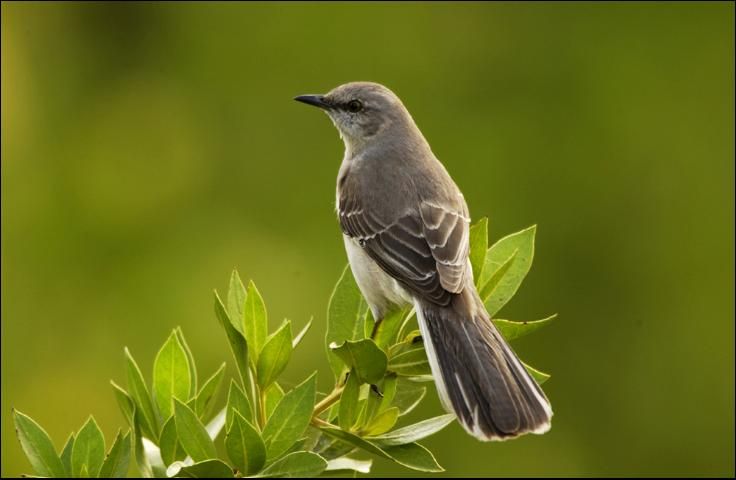
Credit: USFWS
Fun Facts:
- range is expanding northward
- mockingbirds attack other birds during nesting season
- known for singing and ability to mimic other birds
In 1927, the mockingbird was designated as the Florida state bird. The mockingbird is gray with large, white patches on its wings and tail and is noted for its singing ability. Mockingbirds may sing for hours each day and throughout the year to defend their feeding territories. In particular, mockingbirds are skilled in their ability to mimic the songs and calls of other birds. It is believed that they can mimic at least 30 species of birds as well as other sounds, such as barking dogs. The mockingbird is the state bird of four other states. Attempts have been made to change the Florida state bird to the Florida scrub jay, a charismatic, endangered species endemic to Florida, but these have been unsuccessful to date.
Florida State Insect
Zebra butterfly (Heliconius charitonius)
Size: 3–4 inches
Range: southern United States coastal plain, Central America, West Indies, South America
Habitat: hammocks, swamps, forests
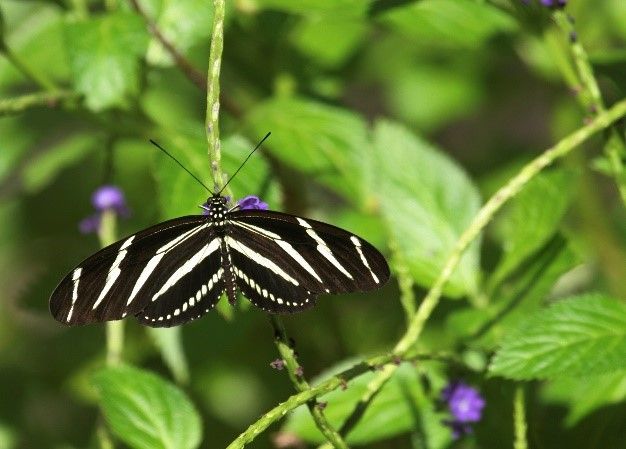
Credit: UF/IFAS
Fun Facts:
- sleep in groups and return to the same roost every night
- older butterflies seem to have first choice at sleeping perches
- at dawn, the first butterfly to awaken rouses the others by gently touching them
Florida's newest state symbol was designated in 1996, at the request of garden clubs across the state. The zebra butterfly (previously called zebra longwing) has elongated, black wings with yellow stripes and long antennae. The butterfly's distinctive pattern resembles shadows and light filtering through the forest canopy. The bold pattern is also believed to serve as warning to predators of the butterfly's nauseating taste, which comes from toxins obtained from eating plants in the passion vine family. Zebra butterflies are unusual in that they cluster at night and sleep in groups, returning repeatedly to the same roost.
Florida State Tree
Sabal palm (Sabal palmetto)
Size: leaf blades—3–4 feet; height—up to 90 feet
Range: North Carolina to Florida
Habitat: wet to dry hammocks/prairies, urban areas, coastal areas.
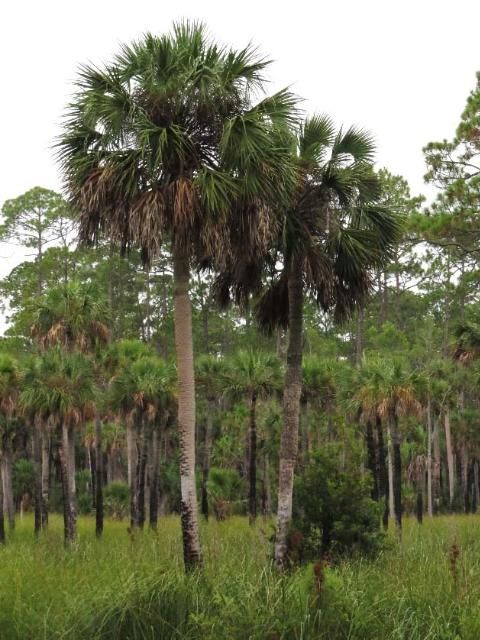
Credit: Megan Ellis
Fun Facts:
- berries eaten by wildlife
- Seminoles used berries in medicinal remedies
- old leaf stalks on trunks (bootjacks) provide habitat for small animals
The sabal palm, also known as the cabbage palm, was designated the state tree in 1953 and occurs on the Florida state seal. Designation as the state tree followed years of debate that considered the royal palm, slash pine, and longleaf pine as other options. Oddly enough, the sabal palm is not a true tree and, as a palm, is more closely related to grasses. Early Floridians had a variety of uses for the sabal palm. The bud of the tree is edible and is known as heart of palm and swamp cabbage; the trunk and fronds were used to build shelter; and various fibrous parts were used to make cordage.
Florida State Wildflower
Coreopsis (Coreopsis species)
Size: 1–3 feet
Range: most of United States
Habitat: wet to dry soils
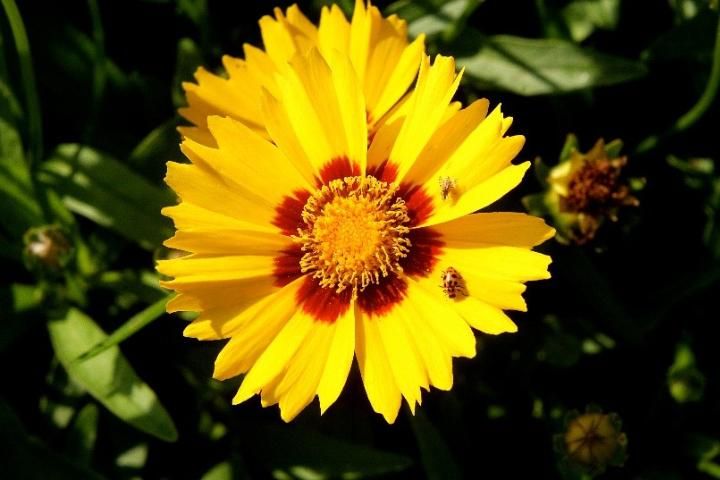
Credit: UF/IFAS
Fun Facts:
- flower heads provide food source for seed-eating birds
- sometimes called tickseed because disc flowers look like small bugs
In 1991, all flowers in the Coreopsis genus were designated as the Florida state wildflower. Thirteen species of Coreopsis occur in Florida, 12 of which are native, including one that is endangered (Coreopsis integrifolia). Coreopsis flowers occur in a variety of colors ranging from yellow to pink and are used extensively in roadside beautification programs.
Florida State Flower
Orange blossom (Citrus species)
Size: average tree height 12 feet
Range: mainly central and south Florida
Habitat: wild species found in hammocks
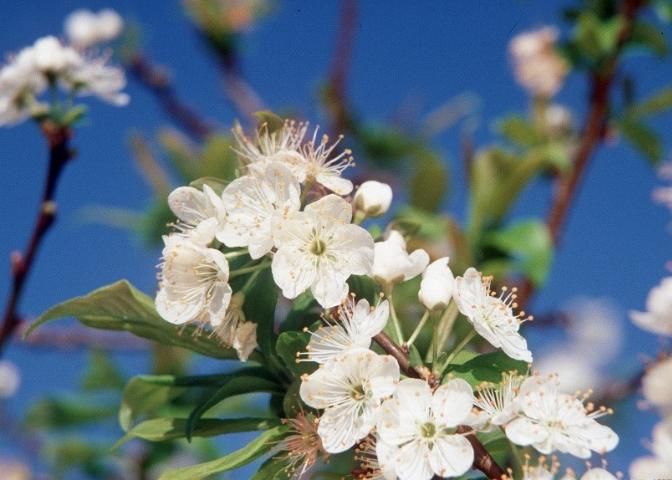
Credit: UF/IFAS
Fun Facts:
- Florida produces the majority of oranges grown in the United States
- 90–95 percent of the Florida orange crop is processed for juice
- orange blossoms are used in tea and bakery products
- most of Florida's honey is produced from bees that gather orange blossom nectar
The orange blossom was Florida's original state flower and was designated as such in 1909. Because the orange tree is not native to Florida, Coreopsis was added as the state wildflower in 1991. Florida's citrus industry developed from 16th century Spanish introductions that grew well and became established in Florida's warm climate. Indians and pioneers transplanted citrus trees throughout the warmer parts of the state. During the 1830s, commercial citrus trees were grafted on sour orange rootstock to improve disease resistance and create a commercial market. Florida quickly became known for its oranges, and orange juice was named the state beverage of Florida in 1967. Today, the Florida citrus industry has an annual economic impact estimated at $9 billion.
Florida State Stone
Agatized coral (Siderastrea species)
Range: In Florida, Tampa Bay, Econfina River, Withlacoochee River, Suwannee River
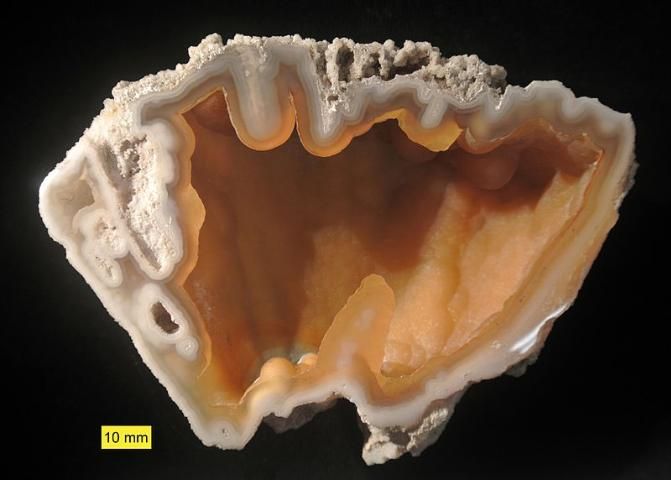
Credit: Mark A. Wilson, Wikimedia Commons
Fun Facts:
- lived 28–23 million years ago (late Oligocene)
Agatized coral was named the state stone of Florida in 1979. Agatized corals are the fossilized remains of coral, which, over time, become geodes lined with smooth, spherical agate. This happens as acidic groundwater dissolves the calcium carbonate skeletons of coral. Dissolved silica partially replaces the calcium carbonate and the water deposits minerals like iron and manganese, creating the cave-like appearance of the stone.
Florida State Soil
Myakka fine sand
Range: peninsular Florida
Habitat: mesic flatwoods
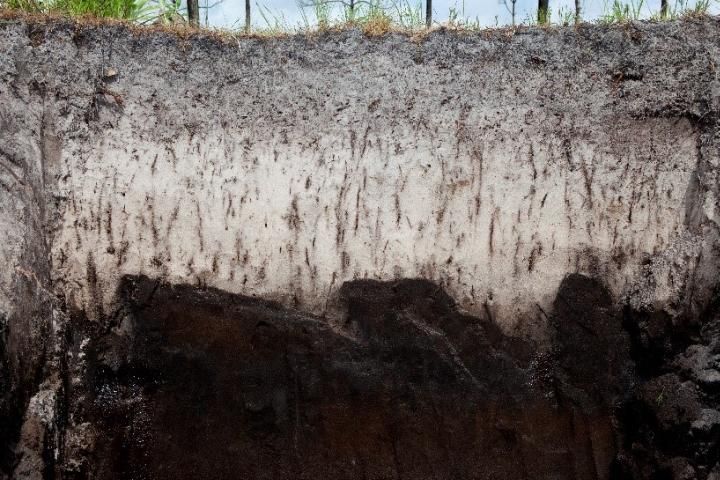
Credit: Tyler Jones, UF/IFAS
Fun Facts:
- formed from sandy marine deposits
- does not occur in any other state; it is endemic to Florida
- Myakka (pronounced My-yak-a) is a Native American word for "big waters"
In May 1989, Myakka fine sand was named the state soil of Florida. Myakka soils consist of very deep, poorly drained sandy soils. These soils are characteristic of Florida's mesic flatwoods where you can find longleaf pine, slash pine, saw palmetto, gallberry, wax myrtle, and many other species. A suite of wildlife species depend on this ecosystem and the soil that makes it possible. Much of this habitat has been converted to commercial forest production, pasture, and citrus.
Florida State Gem
Moonstone
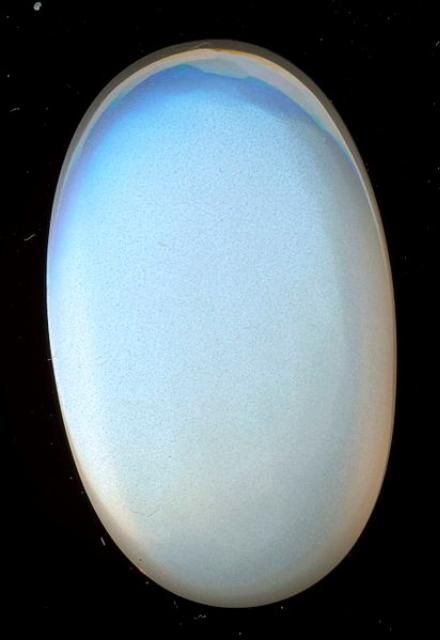
Credit: Wouter Hagens, Wikimedia Commons
Fun Facts:
- not found in Florida
Moonstone was chosen as Florida's state gem to commemorate the many space expeditions launched from Kennedy Space Center in Brevard County, including humankind's first trip to the moon! Moonstone does not occur naturally in Florida and is a form of the mineral feldspar.
Additional Information
Bridges, A., and C. Bester. Micropterus salmoides. Florida Museum of Natural History. Available from https://www.floridamuseum.ufl.edu/discover-fish/species-profiles/micropterus-salmoides/.
Florida Department of Agriculture and Consumer Services. Available from https://www.fdacs.gov.
Florida Fish and Wildlife Conservation Commission. Managed Species: Florida Panther. Available from https://myfwc.com/wildlifehabitats/wildlife/panther/.
Froese, R. and D. Pauly, Editors. 2017. FishBase (version 06/2017). Available from https://www.fishbase.se/search.php.
Gardieff, S. Istiophorus platypterus. Florida Museum of Natural History. Available from https://www.floridamuseum.ufl.edu/discover-fish/species-profiles/istiophorus-platypterus/.
Gilman, E.F., and D.G. Watson. 2013. Sabal Palmetto: Sabel or Cabbage Palm. ENH-733. Gainesville: University of Florida Institute of Food and Agricultural Sciences. https://edis.ifas.ufl.edu/publication/ST575.
Hill, K. 2006. Species Inventory: Trichechus manatus latirostris, Florida Manatee. Smithsonian Marine Station. Available from https://irlspecies.org/taxa/index.php?quicksearchtaxon=Trichechus+manatus+latirostris&taxon=&formsubmit=Search+Terms.
National Oceanic and Atmospheric Administration. Species: Common Bottlenose Dolphin. NOAA Fisheries. Available from https://www.fisheries.noaa.gov/species/common-bottlenose-dolphin.
Portell, R. Object 19: Agatized (Fossil) Coral. Florida Museum of Natural History. Available from https://www.floridamuseum.ufl.edu/100years/agatized-fossil-coral/.
Richardson, L.W., and M.B. Main, 2008. Did I See a Panther? WEC-145. Gainesville: University of Florida Institute of Food and Agricultural Sciences. https://edis.ifas.ufl.edu/publication/UW144.
Sprott, P. and F.J. Mazzotti, 2001. Mockingbirds (Mimus polyglottos) SS-WIS-46. Gainesville: University of Florida Institute of Food and Agricultural Sciences. https://ufdc.ufl.edu/IR00005959/00001
State of Florida. Florida Facts, Florida State Symbols. Florida Department of State. Available from https://dos.myflorida.com/florida-facts/florida-state-symbols/.
Stephens, J.M. 2015. Cabbage, Swamp – Sabal Palmetto (Walt.) Lodd ex Schult. & Schult.f. HS-571. Gainesville: University of Florida Institute of Food and Agricultural Sciences. https://edis.ifas.ufl.edu/publication/MV038.
United State Department of Agriculture. USDA's National Agricultural Statistics Service Florida Field Office. Available from https://www.nass.usda.gov/Statistics_by_State/Florida/index.php.
United State Department of Agriculture. 2013. National Cooperative Soil Survey: Myakka Series. Available from https://soilseries.sc.egov.usda.gov/OSD_Docs/M/MYAKKA.html.
Wildlife Ecology and Conservation Department. 2001. Alligators and Crocodiles, Quick Reference Sheet. WEC-QRS-003. Gainesville: University of Florida Institute of Food and Agricultural Sciences. https://ufdc.ufl.edu/IR00005950/00001.
Wunderlin, R. P., and B. F. Hansen. 2004. Atlas of Florida Plants. Institute for Systematic Botany, University of South Florida, Tampa. Available from https://plantatlas.usf.edu.